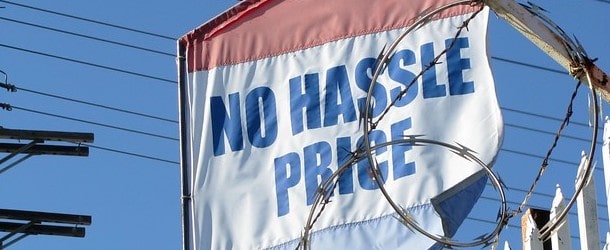Do We Need a Mortgage MSRP?

Mortgage rate pricing can be a bit of a mystery. And also super complex.
I’ve written about it in detail (how mortgage rates are determined). But you could go on and on about it, eventually generating more confusion than clarity.
At the end of the day, there are many different loan types and countless loan scenarios.
There are also thousands of banks, credit unions, mortgage lenders, brokers, and so on.
Which begs the question; do we need a mortgage MSRP?
First Off, What Is MSRP? And Why Is It Useful?
First off, what is MSRP? Well, it stands for manufacturer’s suggested retail price.
It’s essentially what the manufacturer of the product suggests a consumer should pay.
Typically, it’s found at dealerships because auto dealers are required by law to post it on the windows of new vehicles on the lot.
You might also see it on a book at the bookstore, or even a bag of chips at a convenience store.
When purchasing a vehicle, it is known as the “sticker price,” and may include manufacturing and sales costs along with the retailer markup.
It’s all supposed to improve price transparency for the consumer, even though the final sales price could be above or below the MSRP.
But by knowing what the price of an item should be, you’ll know if you’re being overcharged.
For example, if a car has an MSRP of $25,000 and the dealer is attempting to sell it to you for $35,000, you might raise an eyebrow.
This ostensibly makes it more difficult for dealers to rip you off, assuming you don’t know a lot about car prices. Or you simply didn’t do your research beforehand.
The Mortgage Industry Doesn’t Have an MSRP
The mortgage industry does not have an MSRP, but similar to vehicles, pricing is often shrouded in mystery.
If you’ve ever purchased a new car and obtained a home loan, you may have felt some eerie similarities.
Instead of the car salesman “speaking to his manager,” the loan officer might tell you that she has to check pricing with the lock desk.
Or that this is the best that they can do. Meanwhile, you’re given a Loan Estimate (LE) with all types of numbers and other disclosures that create more confusion.
In the end, you’re probably unsure if the rate presented is good or bad. Never mind the mortgage APR, which factors in lender fees.
The one thing the mortgage industry has at the moment that kind of resembles MSPR is the “higher-priced mortgage loan,” which is simply one that exceeds the Average Prime Offer Rate (APOR).
For first-lien mortgages it is considered “higher priced” if the APR exceeds the APOR by 1.5 percentage points.
This number jumps to 2.5 percentage points for jumbo loans and 3.5 percentage points for second mortgages.
While this provides some protection to the borrower, the spread is pretty large. You could still be presented with a rate 1% above market and it wouldn’t be considered “higher priced.”
And even a rate of say .50% higher could result in a big monthly cost compared to a market rate.
On a $500,000 loan set at 6.5%, we’re talking $160 more per month versus a 6% rate. Or nearly $2,000 annually.
How a Mortgage MSRP Would Work
This has led housing policy advocates Laurie Goodman, Ted Tozer, Alexei Alexandrov to propose a “mortgage MSRP” to improve pricing transparency in the mortgage industry.
While there have been efforts by the Consumer Financial Protection Bureau (CFPB) to encourage borrowers to shop around, most borrowers fail to do so.
And the current disclosures are too confusing anyhow, even for those who work in the industry. In the end, most borrowers simply use the first lender they speak with, despite a big disparity in pricing.
Mortgage rates can vary tremendously, even for borrowers with the same exact LTV ratio, FICO score, loan purpose, and so on.
And studies have proven that those who gather additional quotes can save thousands on their mortgage.
To encourage borrowers to shop more, a mortgage MSRP could be published daily.
Both the GSEs (for Fannie Mae and Freddie Mac conforming loans) and the FHA (for FHA loans) could publish a daily rate sheet for prospective borrowers.
It could include APRs for a standard 30-year fixed home purchase loan locked the preceding day.
Additional numbers could be provided, including APRs for rate and term refinances and cash out refinances as well.
Lenders would then be required to disclose this MSRP to borrowers and warn them when the lenders rate quote is above the MSRP.
If so, they’d have to inform borrowers of the difference in monthly payments between the rate offered and the MSRP.
While they note that some borrowers would “be happy to pay more because they like the lender,” others would shop around and/or attempt to negotiate the mortgage rate.
A Mortgage MSRP Could Lead to Lower Pricing
The researchers argue that establishing a mortgage MSRP could lead to lower pricing, a claim backed by empirical evidence.
Additionally, it could result in more uniform pricing with less mortgage rate disparity among lenders.
At the end of the day, a mortgage is mostly a commodity with no material difference other than the service involved during the loan origination process.
After your 30-year fixed-rate home loan funds, it’s no different than someone else’s 30-year fixed-rate home loan.
The only real difference could be the interest rate attached and the lender fees paid. Beyond that, they’re essentially identical.
So having to pay significantly more at one bank doesn’t seem quite fair. Sure, level of service and lender competency (ability to actually close the loan!) have value.
But closing the gap in pricing between mortgage companies, especially higher-priced ones, could benefit home buyers and refinancers everywhere.
It could also improve the mortgage customer experience and the reputation of the industry, which isn’t always seen in the best light.
Comments are closed.